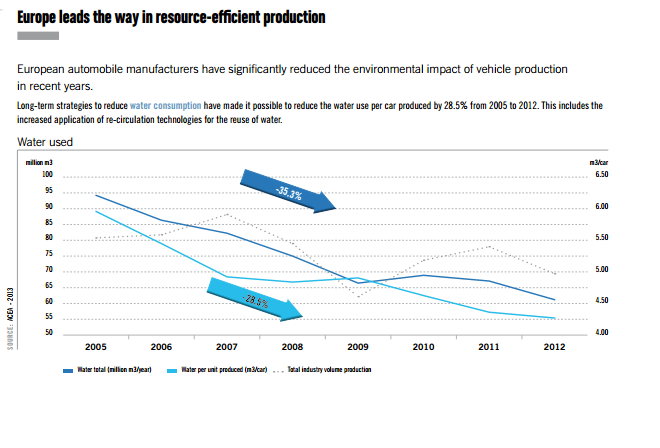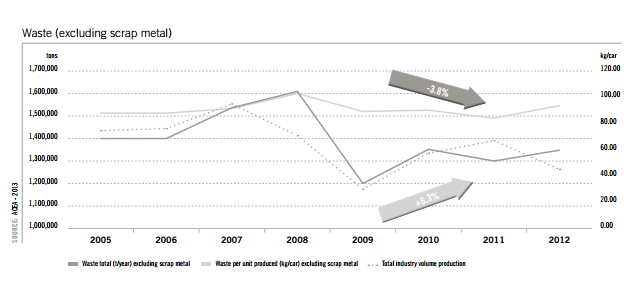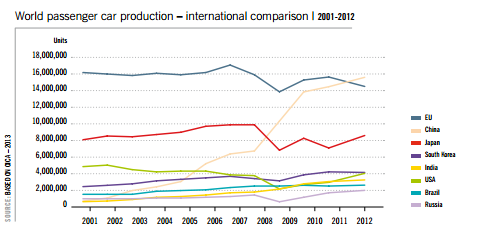Executive Summary
EU automotive industry (AI) policy is concerned with two primary aims: promoting economic growth and ensuring safety and sustainability. The focus of the policy on research and development (R&D) is obvious; it allows the EU industry to fulfil the goals of the region and abide by the numerous regulations. AI contributes to the region’s economic growth significantly; currently, it is in the state of recovering after the crisis of 2007. The EU AI used to be the most productive one in the world. Nowadays, however, the Chinese AI appears to challenge this position. With the Volkswagen emissions scandal, the necessity for a more strict control policy appears to have arisen.
EU AI and EU Policies
When establishing the unified market within the EU, the European Commission [EC] (2015) primarily aimed at promoting progress (both economic and technical) as well as production and distribution of goods. It also endeavoured to liberalise, harmonise, unify and remove trade barriers while encouraging competition (Jeong 2007; Suder 2011). Liberalisation, however, is not to be hindering the processes of economic development, which is why the industries within the EU are subjected to numerous regulations. According to the European Automobile Manufacturers’ Association, ACEA (2013), the AI that it is one of the most regulated industries in Europe (p. 6).
EU AI Policy
EC (2015) chooses to describe the following regulations as the primary parts of the EU AI policy: safety, product liability, and environmental sustainability. Apart from that, the focus of the policies on R&D is obvious.
Safety and Liability
The safety of vehicles within the EU is regulated both through the international standards and those created by the EU and the UN Economic Commission for Europe (UN-ECE). The creation of UN vehicles standards started in 1958; one of the milestones of this process is the introduction of EU Whole Vehicle Type Approval, which, however, does not cover all the types of vehicles yet (EC 2015). Nowadays, the primary directives in this respect include the EU General Product Safety Directive (revised in 2001), but specific provisions for vehicles are being devised as the industry develops. Most recent ones include those concerning frontal and side-impact protection. The tools that are aimed at improving and controlling these sectors include the European New Car Assessment Programme, which is a system of safety tests (EC 2015).
Environmental Sustainability
The AI is affected by the endeavour for environment protection that is generic for the modern developed countries. An example of this endeavour is the EC End Of Life Directive for vehicles (2000/53) that requires reducing the number of hazardous substances used in the production and improving the recycling of materials as well as the usage of the recycled ones (Zorpas & Inglezakis 2012, p. 58).


EU manufacturers seek to make production more effective and sustainable by reducing the usage of water and energy as well as decreasing the production of waste. For example, Figure 1 demonstrates the steady decrease of water consumption by the EU AI throughout past years. Figure 2 demonstrates that the total industry waste has been unevenly decreasing, and the waste per unit produced appears to be increasing (by 6.3%). It is noticeable that the decreasing performance in this respect can be tied to the crisis of 2007. As the EU economy recovers, the performance is expected to improve.
Regulatory Bodies, Associations, and other Bodies
The main AI legislative body is the EC’s Directorate of Enterprise and Industry. The European Enhanced Safety of Vehicles Committee develops general tests for the safety of the vehicles. The number of associations of the EU AI manufacturers, which are supposed to ensure the implementation of the regulations, amounts to twenty-nine (p. 4). Other bodies include the European Council for Automotive R&D that is concerned with providing sustainable, safe, affordable and competitive technology (ACEA 2013, p. 18). The policy and safety research is promoted with the help of international conferences (EC 2015).
It can be concluded that the mechanisms of EU policy implementation are well-developed, and specific attention is paid to the necessity of providing the industry with the means of achieving EU goals, that, is, with new technology.
The Importance of AI for EU
As of 2013, the industry created 12.9 million workplaces (5.3% all the EU workplaces); in the same year, the industry accounted for 25% of R&D spending, becoming the largest R&D investor in the EU (ACEA 2013, p. 21). Apart from that, the industry consumes the products of other industries (for example, chemicals) and accounts for 6.9% of EU GDP (as of 2013). Finally, vehicles are a source of government revenue (taxation) and serve the community by moving people and (ACEA 2013, p. 22). It is not surprising, therefore, that the ACEA (2013) describes the AI as the “engine” of Europe (p. 3).

The EU produces 23.2% of the world’s cars, and the industry is recovering from the drop of the 2007 crisis (ACEA 2013, pp. 35-39). For example, in 2014, 17.2 million vehicles were manufactured in the EU as can be seen in Figure 3 (ACEA 2015b). In 2015 (so far), the production of EU in the industry grew by almost 7%, while the exports increase by 14% (ACEA 2015a, pp. 11-13). It can be also pointed out that such is the world tendency nowadays as the world economy recovers since 2007. Figure 4 shows how the passenger car production accelerates around the world; other automotive sectors mirror its dynamics (ACEA 2013, pp. 39-40).

Economic Strategy Policy: Future of the Industry
According to the Verband der Automobilindustrie (a German AI association) or VDA (2015), EU needs to improve the industry’s competitiveness in the light of the growth rates of China and US production dynamics (see Figure 4). Currently, the 2020 EC strategy includes the objective of increasing the share of manufacturing in GDP to 20%, and the car industry is expected to contribute through the Cars 2020 action plan. The main goal of the plan is to secure the EU position as the #1 manufacturer in the world (VDA 2015). This plan provides the EU manufacturers with recommendations for the improvement of the relations, trade policy, and environmental sustainability. The VDA (2015) admits that the issues of individual EU countries (primarily, Greece) can hinder this process. However, the recent emissions scandal of Volkswagen adds another issue for the EU to be concerned with (Russell et al. 2015).
It can be concluded that the EU has a consistent and developed AI policy with a clear and coherent emphasis on R&D that appears to have defined the position of EU as the number one vehicle manufacturer. Still, the current global economic situation appears to demand policy improvements, which, in turn, seem to be in progress. These improvements should ensure the impossibility of Volkswagen-like scandals and the competitiveness of EU AI.
Reference List
ACEA 2013, The Automotive Industry Guide 2013.
ACEA 2015a, EU Automotive Industry Quarter 3 2015.
ACEA 2015b, EU Production, Web.
European Commission 2015, Car industry policies, Web.
Jeong, C 2007, ‘A Comparative Analysis of the EU Regulation Governing the Automotive Industry and the U.S. Antitrust Law: Suggestions for the Block Exemption Regulation 1400/2002’, Loyola Of Los Angeles International & Comparative Law Review, vol. 29, no. 2, pp. 309-338, via EBSCOhost database.
Russell, K, Gates, G, Keller, J & Watkins, D 2015, ‘How Volkswagen Got Away With Diesel Deception’, The New York Times.
Suder, G 2011, Doing business in Europe, Sage Publications, London.
VDA 2015, EU policy for an efficient automotive industry, Web.
Zorpas, A & Inglezakis, V 2012, ‘Automotive industry challenges in meeting EU 2015 environmental standard’, Technology in Society, vol. 34, no. 1, pp. 55-83, Web.